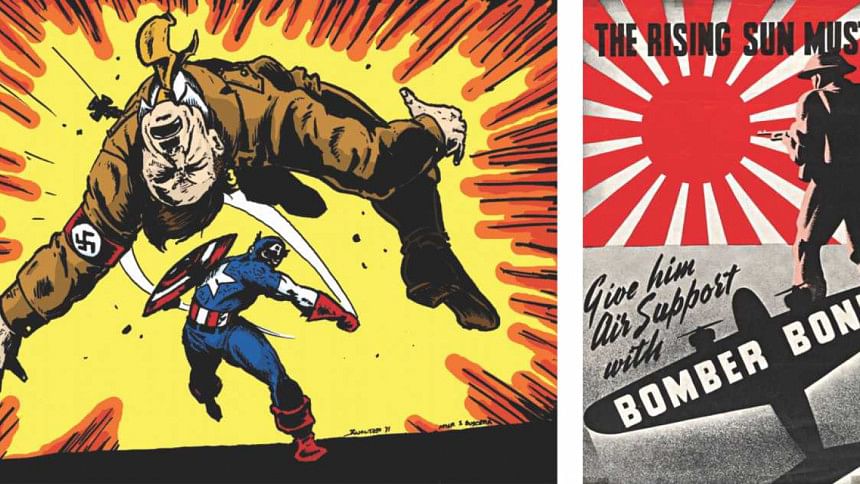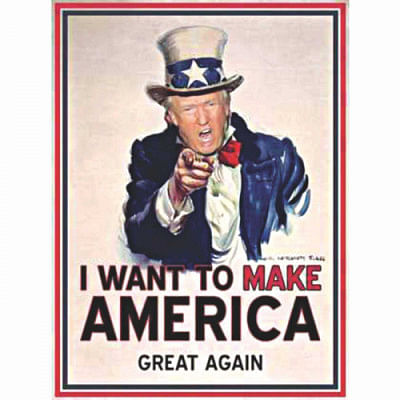WE'RE ALL PROPAGANDISTS

If you're anything like me – alive and on social media – you've seen your fair share of people dissatisfied with modern life and the people who live it. People these days are monstrous and duplicitous, unlike our parents' generation which knew the value of honesty and honour.
This is the sort of thing people just find themselves saying despite it being patently untrue. Historically, people have been, broadly speaking, just a bunch of turds. And I'm not just talking about the wars, genocides and religious persecution. They have also been liars to a degree that would make the Trump press team frown.
Propaganda is "information, especially of a biased or misleading nature, used to promote a political cause or point of view" according to the Oxford Online. This of course means that you and I have been propagandists since we were old enough to have opinions, but it's the "especially" that we should be playing close attention to here. The art of presenting a one-sided or twisty-fact version of events that make your chosen cause look good is prevalent everywhere from personal gossip to international politics. In fact that is and has always been the default in many places – just try convincing people that maybe communism/capitalism isn't so bad, that democracy isn't perfect, or that other religions have ideas of merit too.
This is what makes propaganda so insidious: the lies and bias are rarely inserted as part of some moustache-twirling, villainous scheme to dupe the public to go along with some nefarious plot. Often enough it's done with good intentions.
Though propaganda as a deliberate thing is old, with mentions as far back as 515 BC, it wasn't until the development of the printing press in Europe that it started to take off. The Reformation, as the name suggests, was a time of great social turmoil in Europe with the introduction of new ideas and criticisms of the old order. The printing press was an integral weapon in the fight between Protestants and Catholics, with the theological dispute taking the form of propaganda to sway Christian Europe one way or another. The war of ideas was once again fought through the printed word during the American Revolution, with publications urging their readers to support or denounce independence. The propagandists of the Reformation and the Revolution were not idle provocateurs. The causes being argued and fought over were of vital importance to the participants: the fate of colonial America and the soul of Christendom are deadly serious topics. Stretching the truth or slanting the discourse was hardly immoral when the stakes were so high.

These early examples of propaganda were strong on visual imagery: Benjamin Franklin's divided, dying snake to convince the American colonies to unite for independence shows well how advanced propaganda was even in its relative infancy. Cartoons and posters constitute some of the most iconic pieces of propaganda: consider the iconic "Kitchener Wants You" poster and its American variant during WWII, or even our own war's "Annihilate these Demons". Communist regimes were notorious for commissioning artists to paint idealised versions of their nations, a practice that continues in places such as modern North Korea.
Modern media such as photography, film and radio are equally important, and all were heavily used during World War II to drum up support. Nazi Germany in particular is almost synonymous with propaganda in films, but Hollywood was no slouch either. Many of the most iconic propaganda films of this era are still well-regarded, most notably Casablanca and Chaplin's The Great Dictator. Animation and comic books were nascent industries that also were employed in the war effort: not just the obvious American examples of Disney and Looney Tunes but even in the USSR made animated propaganda. The first issue of Captain America showed the superhero punching Hitler on the cover, which would in an ideal world silence anyone muttering about how today's comics have too much politics in them – but of course it won't.
Image manipulation is as old as photography, with some famous early examples being Stalin editing out from official photos everyone he fell out with. Today it is a powerful arsenal in the hands of those who wish to spread that new buzzword "fake news" – tremendously successful at it as well, to the point where legitimate ideas and images that make us uncomfortable can easily be dismissed as hoaxes. We have all of us received images that purport to prove instances of persecution. Placed under any scrutiny the lie collapses, but the idea has already spread.
How can we defend ourselves against propaganda if not by maintaining an insufferable air of cynical scepticism? It's not enough to throw around platitudes on how we can't allow ourselves to be manipulated into supporting causes, because even the noblest causes are perpetuated with lies and deliberate misleading.
Though there is a disturbing trend towards mainstream racism against black people it is still a rare American who would argue that the abolition of slavery was a bad cause. Yet the Abolitionists deliberately played up the physical mistreatment of slaves by their owners. What Karen Halttunen calls 'the Pornography of Pain' was brought out in graphic descriptions and even photographs of whip scars and punitive mutilation. The accuracy of these accounts and images as a general representation of the slave system is debatable, but they were certainly effective in getting people to condemn the system.
What should the public have done instead? Examined the evidence with intellectual rigor, thereby giving slavery the benefit of the doubt? We might agree that some causes are more important than factual accuracy – but what you stand for, what you lie for, are not universal.
Maybe the best we can hope for is to at least refrain from lying to ourselves.
Zoheb Mashiur is a prematurely balding man with bad facial hair and so does his best to avoid people. Ruin his efforts by writing to [email protected]

 For all latest news, follow The Daily Star's Google News channel.
For all latest news, follow The Daily Star's Google News channel. 



Comments